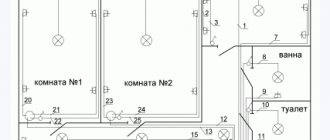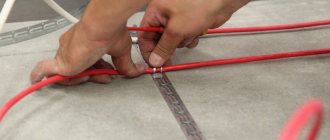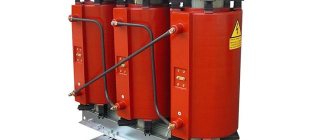Home » Heating » Heating installation » Which greenhouse heating to choose?
Today, greenhouse heating is a fairly important element. It is best to organize electric heating in a greenhouse. With its help, you can control heaters in semi-automatic mode.
Electric heaters for greenhouses are quite economical. In this article you will find the most effective schemes for heating a greenhouse with electricity. For electric heating of a greenhouse, you can use several heater options. A simple heating method can be considered by laying a heating cable in the greenhouse. An alternative heating option can be the connection of infrared heaters. The most labor-intensive option can be considered connecting an electric boiler in a greenhouse. Now we can examine each of these systems in detail.
Which greenhouse heating to choose?
Today, greenhouse heating is a fairly important element. It is best to organize electric heating in a greenhouse. With its help, you can control heaters in semi-automatic mode.
Electric heaters for greenhouses are quite economical. In this article you will find the most effective schemes for heating a greenhouse with electricity. For electric heating of a greenhouse, you can use several heater options. A simple heating method can be considered by laying a heating cable in the greenhouse. An alternative heating option can be the connection of infrared heaters. The most labor-intensive option can be considered connecting an electric boiler in a greenhouse. Now we can examine each of these systems in detail.
Methods of heating a greenhouse
In fact, heating the air in a room can occur in two ways - natural or artificial . Natural heating is carried out using sunlight that passes through the greenhouse roof covering, creating a greenhouse effect, and thus warming the ground and vegetation. The greenhouse is heated in the spring in this way. Therefore, you need to pay due attention to the location of the greenhouse, where the sun will “delight” the green inhabitants as much as possible. But the greenhouse should be protected from drafts that will cool the coating.
For those who want to enjoy vegetables, fruits and beautiful flowers all year round, you will need to install technical heating , which in winter will complement natural solar heating.
There are many ways to heat a greenhouse in winter. Today, the key types of heating are electric , solid fuel (stove) , water, air and gas . You can combine different heating methods, highlighting the main type of heating and an additional source.
Heating cable in a greenhouse
The greenhouse can be heated using a heating cable. If you choose this method, then the greenhouse heating scheme will look like this:
Here is the “pie” that this scheme will consist of:
In this case, your cable will be able to heat the soil to the required level. If you cannot secure the heating cable underground, then you need to lay it along the wall. The electric heating circuit of the greenhouse in this case will look like this:
After you install the heating cable, the system will look like this:
Instead of a heating cable, you can also use ENGL-2 tape. Its installation should be carried out according to a similar scheme.
Water heating
The heat source is hot water circulating through pipes that are laid inside the greenhouse or under the floor.
The diagram and principle of operation of water heating in a greenhouse is as follows: a coolant (heated water) circulates through pipes closed in the system, which, having released heat into the atmosphere, again enters the boiler, where it is heated again.
A larger number of pipes allows you to lower the water heating temperature. It should be noted that the pipe system tends to heat up rather slowly.
The boiler is the main element of such heating for greenhouses. Its choice is determined by the specific situation.
In areas where a gas pipeline is laid, gas boilers are often in demand as the most economical option.
While the heating is powered by electricity, the following happens: the water heated in the boiler is supplied through a circulation pump into pipes that can be laid along the walls of the greenhouse or between the plants.
When installing a water heating system, copper, steel and plastic pipes are used. The latter are exactly what is needed in this case. They are lightweight, affordable, and do not rust.
The circulation of water in the system is usually forced, facilitated by an installed pump, or less often - natural.
When connecting thermostats to pipelines and radiators, it becomes possible to maintain a certain temperature automatically.
When laying pipes for subsurface heating, you need to take into account that steel is not suitable for these purposes. Metal corrosion will destroy and disable such a heating system.
The disadvantages of water heating of a greenhouse include the complexity of installing the pipe system, the high price and the need for constant monitoring.
The positive side is that simultaneous heating of the air and soil occurs.
Infrared heaters
If you have already built it, then it is impossible to heat the greenhouse using a heating cable. In this case, ceiling infrared heaters are suitable for you. They are capable of not only warming up the room, but also doing it in a semi-automatic mode. A typical infrared heating scheme in a greenhouse looks like this:
If necessary, you can place the heating of the greenhouse using infrared heaters on the wall.
Types of IR heaters
All IR heaters for greenhouses operate on electricity. However, using the same energy carrier, they can have different designs.
Hull
Such devices are also called lamp IR heaters. The emitter is a spiral placed in a quartz tube (protected from dust), fixed in a reflector.
Case IR heater
Cabinet IR heaters are mounted at the top - on the wall or under the ceiling. The minimum distance to plants is 1-1.5 m (depending on power).
Film
Between the two layers of polyester there are tracks of carbon paste. In fact, such devices are not infrared: they heat up to a temperature no higher than +400C (with poor heat dissipation - up to +700C), so they emit even less intense IR radiation than a regular heating radiator.
For comparison: the coil of an IR lamp heater heats up to a temperature of 600C (until a red glow).
A film heater gives off heat by contact, so it is laid in the ground like a heating cable. Using such a heater in a greenhouse is dangerous!
A thin insulating film is easily damaged (the insulation of a heating cable is much thicker), as a result of which, when watering, water can get on conductive elements with subsequent electrical injury to the user.
Tape
These heaters are designed similarly to film heaters, but have a small width, equal to a garden bed. This allows you to save money by placing heating devices only under the plants.
Belt heaters are also installed vertically between rows. In this position, they heat the air like low-temperature radiators of a large area.
Heating a greenhouse with an electric boiler
This method of heating a greenhouse is considered the last. In this case, you need to use water heaters or heated pipe floors.
Of all the schemes for heating a greenhouse with electricity that we provided, this one is the most labor-intensive. Despite these factors, heating a greenhouse with an electric boiler is very popular. If necessary, you can also connect an electrode boiler here.
These were the most effective schemes for heating a greenhouse with electricity. We hope you find these diagrams useful.
Similar articles on the topic
I have been involved in greenhouse activities for a long time. However, installing heating in a greenhouse has always raised a lot of difficult questions. The most important thing is what type of heating is best suited, and how to correctly draw up a heat distribution scheme over the entire area. That’s why I started looking for information on the Internet, since I didn’t have any acquaintances in this matter who could help. Only by going to this resource, I finally found decent and understandable information on all stages of heating installation and its selection. Very satisfied!
Source of the article: https://vse-elektrichestvo.ru/otoplenie/montazh-otopleniya/otoplenie-teplicy.html
Gas heating boilers
Boilers using gas as fuel are considered the most convenient and economical. Installing them with your own hands is not difficult, and even the largest buildings can be heated using such a system.
Gas boilers can be:
- Single-circuit, designed to heat only air or soil;
- Double-circuit, capable of warming both the soil and the air to the required level.
For small rooms that are not used in winter, or those built in regions where there is no frost, a single-circuit gas stove will be sufficient, which will warm the soil or warm the air, extending the life of the greenhouse. Double-circuit systems are useful in large, capital buildings, in which the cultivation of fresh herbs does not stop all year round. If the greenhouse uses a double-circuit gas boiler, then one pipe, through which smoke from fuel combustion flows, is laid underground, and the second, with hot air, is laid along the top and walls of the greenhouse.
Depending on the size of the room, a direct draft or forced draft boiler can be installed in the greenhouse. The first type is based on air circulation inside the greenhouse itself, and the second is on the forced drawing in of air from outside and, accordingly, increasing the volume of air flow.
Infrared gas heaters are an excellent option for quickly raising and maintaining temperature for a short time if the main heating system in the greenhouse fails. The device consists of two parts - an infrared heater, with tubes in which gas burns, reflectors, and a small gas cylinder. Inside the tubes of the device, fuel burns and is converted into infrared radiation, which heats the soil, plants and walls of the greenhouse. It is irrational to constantly use such a device due to the relatively small power and fuel reserve, but in case of frost, turning on a gas IR heater will help save plants from the cold.
Gas boilers are considered the most popular in their class. Fuel for them is cheap and easy to buy, the system does not depend on the supply of electricity and does not consume it, and such a boiler can be installed even in a small greenhouse. But at the same time, the boiler is not considered fireproof, like any gas appliances, it has large dimensions and requires the installation of a chimney.
With the help of gas, not only air, but also water can be heated. Water in water boilers and heating systems is often heated with this type of fuel.
Industrial farm greenhouses from the manufacturer in Belgorod
A boiler for greenhouses is the equipment that will allow you to get a good harvest even in severe frosts. Everyone knows how much vegetables cost in winter, so bringing your own vegetables during this period is a very profitable solution. But every vegetable grower who decides to start heating a greenhouse may face the difficulty of choosing a boiler, because there are several varieties on the market. Which one should you choose for this or that site? Or maybe it would be easier and cheaper to make it yourself from scrap materials?
The best manufacturers
The heater is chosen for more than one season. When you give your hard-earned money for an electrical appliance, you want to be sure that it will last long enough. The world's best manufacturers, whose popular models do not require additional advertising, can guarantee high quality.
Ballu
Many buyers have managed to appreciate the products of this international holding, a world leader in the production of climate control equipment. The company's product range includes more than three hundred items of household and industrial equipment:
- humidifiers and dehumidifiers; coolers and heaters;
- convection, infrared, ground, water, gas heaters;
- hand dryers;
- air conditioners, split systems, etc.
It all started at the end of the 20th century with a small company producing refrigerators and freezers BLR “Bai Lunyu Refrigerated Equipment Entertainment” in the town of Keelung near Taipei, the capital of Taiwan. Today it is a multinational corporation headquartered in Hong Kong.
MO-EL
The Italian company Moel by SALKA specializes in the production of pest control products. At the same time, climate control devices have been developed and produced: IR heaters, hand dryers, hair dryers, heating equipment, etc. The functionality of some models can be supplemented with various devices, incl. air ionizer. The popularity of the company's models is explained by the constant search for new technical solutions.
Timberk Tech
The Swedish manufacturer is a recognized leader in the production of climate control equipment. The company's products undergo rigorous quality control at each processing stage. The latest technologies are used in the production process. Buyers highly value products bearing the Timberk brand for their high quality, affordable prices and the regular appearance of new products on sale.
Electrolux
A Swedish company known throughout the world for its high-quality household appliances. All housewives know her products. These are washing machines and dishwashers, irons and steam generators, vacuum cleaners and kitchen appliances. Among all this diversity, there was a place for all kinds of heaters, convection, infrared, etc. Users note the high build quality and excellent design of Electrolux products. In 2014, the company supplied equipment to hotels in Sochi, in preparation for the Olympic Games.
SST Group of Companies
“Special systems and technologies” is the abbreviation for the SST group of companies. Specialization – heating cables and electrical heating systems, industrial and domestic. Here are sets of heated floors and systems for heating pipes, deicers. The largest manufacturer of such products in Russia. In terms of production volume, it is one of the largest in Europe. SST (more than 1000 items).
Green Box Agro
The brand belongs to the SST group of companies. Produces sets of ground heating systems: consisting of: cable of various lengths, temperature controller. Purpose – heating the soil in greenhouses of various sizes.
Heatline
Russian manufacturer of heating cables: resistive, self-regulating, ultra-thin. With the help of equipment produced by the company, industrial tanks, containers, and pipelines are heated. The company's engineers constantly solve problems to improve the energy efficiency of their designs.
Sokol-Electro
Domestic manufacturer with a rich history. In 1877, Russian Army Colonel Boris Ivanovich Wiener founded the Ekaterininsky Powder Factory. By the beginning of the 20th century, the company became the largest private supplier of gunpowder for the Russian army. One of the company's shareholders was Emmanuel Nobel, the father of the future founder of the most prestigious prize in the world. Today the company produces electrical products, including heating tapes, which are in demand among greenhouse owners.
Thermophone
Russian company. On the market for more than 20 years. Specialization – development and production of budget infrared emitters. The company constantly uses innovative technologies in its models. The head of the enterprise has a scientific degree in the field of application of IR emitters in agriculture. The company's products can be used to heat large areas.
Soft Term
Domestic manufacturer of low-temperature IR heaters. The company is the owner of the STEP brand. The company provides a full range of services at the buyer’s request:
- will analyze energy consumption at the customer’s site free of charge;
- will perform calculations of power and payback period;
- optimizes the layout of heaters;
- will ensure delivery of equipment to the site.
Supra
The Japanese corporation is one of the recognized world leaders in the production of consumer electronics. Its products are in demand all over the world, thanks to the successful ratio of high quality and affordable prices. The company was founded in 1974. Today it is an international concern with production facilities around the world.
Hyundai
A well-known South Korean company known as a car manufacturer. However, models of convectors, IR emitters, fan heaters, etc. are widely represented on the climate technology market. They are popular among buyers due to their high-quality assembly, innovative technical solutions and affordable price.
There are enough companies on the market that produce high-quality heaters of various types. The buyer decides which company equipment is best to buy, taking into account his financial capabilities.
In any case, you should listen to the advice of experienced users, recommendations of sales consultants in specialized stores, find out how much a suitable model costs, carefully study the description and step-by-step operating instructions. All this information will help you avoid making mistakes when choosing a heater for your greenhouse.
Boiler options for greenhouses
At the moment, the following boilers for greenhouses are widely used:
- wood;
- combined (wood-coal);
- pellet;
- gas;
- electric.
Conventionally, they are classified into two more subspecies. Solid fuel boilers are the first three types above. Long-burning boilers are included in a separate category, since the principle of their operation is not based on the combustion of materials, but on their smoldering, for which a system of controlled oxygen (air) supply is used. They are the most effective and economical, but are quite expensive.
Air heating
It is easier to build air heating for a greenhouse with your own hands than water heating.
With this method, air is used as a coolant.
It is pumped between the walls of the boiler and the firebox, heating up, and then it is distributed through the air duct system.
A perforated polyethylene sleeve is laid around the perimeter of the entire room. Warm air flows through it, which evenly warms the soil.
The advantage of this method is the quick heating of a greenhouse of any size.
The disadvantage of this heating system is that you have to constantly monitor the humidity in the greenhouse. This heating method helps to sharply reduce it.
Making a greenhouse boiler with your own hands
The first step towards self-installation of heating equipment in order to create a heated greenhouse in a personal household should be a detailed drawing of the planned heating installation. The required power is also calculated based on the area and volume of the room, type of boiler, type of fuel, operating time, etc. After a painstaking process of theoretical pre-preparation, one should proceed to the main stages of creating a boiler.
Materials and tools
For a simple solid fuel boiler model you will need:
- A metal barrel with holes or an old gas cylinder, sawn in half.
- Water circuit or coil.
- Hinges, metal handles, matching latches, etc.
- Welding machine.
- Cutting tools.
Construction and connection
The most common model of a homemade boiler looks like this:
- The cylinder (barrel) is placed in a metal oven.
- A chimney pipe is welded to the resulting structure, through which gases will be discharged from the greenhouse premises to the outside.
- The last stage is welding pipes (plastic, metal) together and their further installation.
Video: how to make a solid fuel boiler with your own hands
Types of boilers
Below is a more detailed description of the various devices.
Important! If a cyclic heating mode is used, then it is recommended to use a non-freezing liquid or antifreeze as a coolant liquid.
Gas
It operates using liquefied or natural gas, and water of any quality is used. The boiler is installed in a greenhouse in a free space. The device includes a heat exchanger, an atmospheric burner, a pump, an expander (tank), and a safety valve. A working boiler heats water in a heat exchanger and uses a pump to supply it to the system circuit. The smoke is diverted and removed through a chimney or pipe.
Register - heating equipment consisting of smooth-walled pipes connected to each other by welding. Typically, the tubes are arranged horizontally and secured to each other by vertical jumpers, through which the coolant also moves. Registers are often installed in heating systems intended for technical and industrial premises.
Algorithm for connecting the register to the main unit:
- Understand where the hot and cold water inlet and outlet are located in the water circuit.
- In the end parts of the register, holes are drilled for threaded couplings, which are the basis for fittings connecting the heat exchanger to the water circuit.
- Using a welding machine, the air vent is secured (from the supply - on the opposite side). The optimal location for attaching the valve is the top.
- Considering the large mass of the register, a reliable fastening system should be provided. When placed on the floor, these are stable legs and additional fixation to the wall.
- A distance of at least 25 cm is maintained between the register and the surrounding walls or objects.
Did you know? The first armored car in history was designed in 1916
—
the basis of its body was a boiler brought from the Guinness brewery.
- Advantages of heating a greenhouse using a gas boiler:
- ease of maintenance;
- very fast heating and uniform distribution of warm air inside the greenhouse.
- Flaws:
- Since the installation of the above-described equipment is advisable in large-volume greenhouses, the price of the system will be high.
- Approval is required for connecting equipment and gas supply, which also involves significant material costs.
Solid fuel or pyrolysis
Pyrolysis is a chemical process that occurs at high temperatures and low oxygen content in the combustion chamber, which releases excess thermal energy. In solid fuel pyrolysis boilers, wood (or other solid fuel) is burned with the release of pyrolysis gas and the formation of coal residues. In boilers of this type, the generated gas is subsequently burned. During the combustion process, carbon is oxidized not to CO², but to CO (carbon monoxide).
List of fuel types for pyrolysis boilers:
- firewood
- briquettes;
- sawdust, chopped branches;
- pellets;
- coke;
- coal;
- peat.
Wood is most preferable, since the process proceeds with the maximum release of pyrolysis gas.
You can use a combination of firewood with sawdust, branches and pellets. It is not worth burning with sawdust or finely chopped branches, as the boiler will not work or the efficiency will be extremely low. Important! In rooms with large heat losses (solid glazing, drafts, high ceilings), it is necessary to install a boiler with increased power. If the generation of hot water supply equipment is implied , the calculated
power increases by another 20
-
50%.
The sequence of operating processes for a solid fuel (wood) pyrolysis boiler:
- Firewood is loaded onto the grate.
- After igniting the fuel, close the door tightly and open the smoke exhauster.
- Air begins to flow into the upper chamber due to the pressure difference.
- The resulting pyrolysis gas falls into the lower furnace, in which it burns.
- After a period of time, the air circulation stabilizes, combustion in the fireboxes proceeds evenly. It is necessary to monitor the stability of the processes occurring in the upper and lower furnaces, and promptly remove ash from the lower chamber.
- During the combustion of the top layer of fuel, the funnel-shaped distributor is lowered, thereby supplying air for permanent combustion.
- Gases formed during the combustion process are discharged through the chimney.
- Advantages:
- Efficiency reaches 90%;
- long interval between fuel loadings (up to several days);
- combustion is constant, therefore, the temperature of the coolant is stable;
- comfort in equipment maintenance.
- Flaws:
- considerable dimensions. The height of a pyrolysis oven is higher than that of a conventional wood-burning oven;
- the loaded fuel must be completely dry;
- During the combustion process, carbon monoxide is released - it is necessary to carefully monitor the CO level sensors;
- high price.
Electrical
Electric boilers in small greenhouses are connected to a 220 V network. For greenhouses with large areas - from 100 sq. m and above, the project provides for three-phase high-power units that are powered from a 380 V network. Equipment (pipes, radiators, etc.) is usually connected to the electric boiler so that additional water and electric heating of the entire volume of the greenhouse is possible.
- The undoubted advantages of this type of system include the following:
- ease of installation, operation and maintenance;
- environmental friendliness (no waste from the combustion process, as well as noise during operation);
- small sizes;
- reliability.
- The disadvantages include the following factors:
- high cost of energy;
- constant electrical power is required.
Diesel
Diesel boilers are rarely used to maintain the temperature inside the greenhouse. This is due to the fact that in addition to the large dimensions of the unit itself, it is necessary to provide an additional location for the fuel tank. In addition, additional equipment with convectors and (or) pipelines will be required.
Important! If you plan to connect a gas boiler to a homemade heating system, the participation of a gas technician is required. In this case, independent work is prohibited!
- The undoubted advantages are:
- high efficiency;
- automatic fuel supply;
- relatively low price of the boiler.
- Flaws:
- high cost of fuel;
- large dimensions;
- noise during operation, the unit emits a persistent specific odor;
- the need to install a chimney;
- fire hazard.
Waste oil devices
Installing a heat generator that works using any available waste oil (machine, pyrolysis, animal and vegetable oils, crude oil, kerosene, etc.) allows you to heat the room using hot air. A stove of this operating principle is also installed as an additional heat source for an existing one. When used independently, this type of device requires the installation of a chimney and a fuel tank, which is not a costly undertaking.
- Pros:
- low cost of fuel raw materials. “Exhaust” devices are especially beneficial for those who have constant access to a fuel resource (pizzerias, fast food restaurants, service stations);
- rapid heating of the room due to high heat transfer;
- low cost of the repair kit.
- Minuses:
- increased oxygen consumption.
Combined
Boilers of this type allow the use of various types of fuel in any combination (depending on the model and manufacturer). Initially, it is necessary to decide which type of fuel will be a priority and which will be a secondary one. This type of equipment is often formed according to the principle of a designer.
Just like a single-fuel boiler, the main elements of a combined boiler are a heat exchanger, a reliably insulated casing (minimizing heat loss), and an automatic control system. For household needs, when operating in small spaces, the choice is a double-circuit boiler with the ability to operate on two types of fuel.
- Positive points:
- uninterrupted operation;
- selection of the preferred fuel at the time of operation of the unit;
- ease of use.
- Flaws:
- high price;
- complex setup;
- expensive repairs;
- the need to store several types of fuel raw materials.
Which boiler to choose for a greenhouse
When choosing a boiler for heating greenhouses, you need to take into account both the area of the heated room and your financial capabilities. Ideal - long burning, but they cost an average of 100 thousand rubles. But their consumption is 2 styling for 24 hours. In large greenhouses, they completely pay for themselves in just 1-2 seasons (if the firewood or coal is purchased). In small ones, with an area of about 15-20 square meters, the payback will stretch over almost 10 seasons.
For the latter option, simple solid fuel heating boilers or those that run on gas would be ideal. The efficiency of the system will be significantly higher if it is supplemented with a pump for pumping water through pipes. This, by the way, will ensure uniform heating of the heated room.
An electric boiler, as practice shows, is a pointless waste of money. They are inefficient, use too much electricity, and only increase the temperature at the top of the greenhouse. The volume near the ground remains cold, which leads to freezing of plants.
Rating of heaters for greenhouses
You can heat a greenhouse in different ways. When compiling the rating, our team studied the main options for heating rooms, from primitive and low-cost to technically complex and expensive. Each of them has its own advantages and disadvantages. Water heating, heat guns, electric panels and infrared emitters - all of the heating methods listed have their own characteristics, advantages and disadvantages.
Some are highly effective, but their implementation is associated with serious costs of labor and material resources, and they will pay for themselves only in reputable and profitable farms. Others do not require special material costs, can be installed within a few hours, but are ineffective and consume a significant amount of energy resources. Our task is to select inexpensive, effective and economical devices that do not require complex installation and the constant presence of the owner during operation, such as when using a potbelly stove.
When selecting nominees for the rating, our experts paid special attention to the following characteristics and functions of the devices:
- Model sizes. The heater should not clutter up the work space;
- Weight. Lightweight greenhouse structures will not withstand heavy equipment;
- Power. It should be enough to effectively heat the soil and plants;
- Cost-effective – The model must provide the desired effect with minimal costs;
- Autonomy. Preference was given to devices whose operation can be programmed to automatically maintain a set temperature in the room around the clock.
- Price. Nominees with the best price-quality ratio were selected;
- Safety. Models that meet all electrical safety requirements were selected.
A team of experts took part in compiling the rating, which included experienced gardeners who have been using heaters of various designs for many years, electricians with extensive experience, and sales consultants in specialized stores. Considering their competence and high level of professionalism, we can confidently recommend any of the seven nominees presented to customers.
Possible problems with a homemade device
- The most common problems when operating a homemade heating unit are:
- uneven heating of the internal space;
- excessive dry air.
Both factors negatively affect the condition of the plants in the greenhouse, so you should be especially careful when laying air pipes and providing additional air humidification. Undoubtedly, the selection and installation of technically complex, expensive equipment requires a considerable amount of time and effort to study the issue. However, these efforts can be attributed to a prolonged investment in a future rich harvest, which will delight you both morally and materially for more than one season.
Wood heating
When choosing a heating option for a greenhouse space, taking into account the increase in electricity and gas tariffs that occurs with enviable regularity, it is worth paying attention to an alternative method - heating the greenhouse with wood.
Buleryan type ovens are very suitable for this purpose. Their use allows you to organize the heating of the greenhouse in such a way that night trips for the next laying of firewood are not required. The room heats up quickly, and the temperature is maintained at the set level for a long time.
One stack of firewood is enough for 6-8 hours. The stove body does not heat up, which completely ensures safety.
You can build a stove for heating greenhouses with your own hands, or, as an option, a stove with a horizontal chimney.
Its structure is as follows: in the vestibule a firebox is made of brick, and in the greenhouse, along its entire length, a chimney is laid under the shelving. It is through this that carbon monoxide passes and leaves the room through the pipe on the other side.
The heat released during this process warms our building.
Emergency heating boilers
An experienced vegetable grower always has different types of heating boilers at his disposal, since one of them may turn off due to an interruption in gas supply, electricity, or simply break down. So, for emergency situations, electric ones are ideal, where the heating element is heated, and the heat is dissipated by a cooler. But they should be supplemented with an autonomous generator.
The most ordinary wood-burning stove is also an excellent solution for emergency heating of the greenhouse volume. But its construction should be done in advance. Smoke removal can be done in several ways. But we must not forget that vaporous gas is not harmful to plants and reduces thermal conductivity. Thanks to this, the cooling rate of the greenhouse will be significantly reduced.
Every vegetable grower could use a mobile pellet boiler. It is quite easy to transport, but it is useful for burning any solid fuel, including corn cobs. At the same time, heating occurs quickly and evenly. The only drawback is the need to have a chimney, and in strong winds it will blow in from the outside. That is, a large amount of smoke will enter the greenhouse. Plus, pellet boilers are demanding to maintain. They quickly accumulate moisture, which can only be removed mechanically. In any case, this is an excellent option for emergency heating, in which fuel can even be combined (for example, kindling with wood, maintaining temperature with coal or peat).
Advantages and disadvantages of different methods of organizing heating in greenhouses
Choosing a soil heating system in greenhouses is often fraught with difficulties. There are many options - from basic to “smart” systems. Therefore, it is advisable to consider the strengths and weaknesses of each method:
- convection, natural or artificial, is the simplest method in which the greenhouse space is heated due to the influx of warm air mass. They use solar panels, stoves, open burners, fireplaces, and electric convectors. But the downside lies in uneven heating and difficult controls;
- the use of collectors - a system of pipes is distributed over the desired plot of land, and coolant circulates through them. It can be steam, water, air. This method is more difficult to install, but contributes to a more even distribution of the coolant. Furnaces and boilers become energy generators;
- infrared heating - includes the use of heating film and convectors. The main advantage is that the infrared heat source warms up the surfaces of objects rather than the air, which helps save energy. However, the organization of infrared heating itself costs a lot, and besides, an accurate calculation of devices for a specific area is required;
- heating the soil in a greenhouse with a cable is considered the most energy-efficient and compact, since almost all communications are located underground. The existing disadvantage is considered relative - the wires do not produce very high temperatures, it is recommended that they be laid in insulated areas.
Some vegetable growers prefer elementary methods - solar and biological. Only solar means dependence on weather conditions and the absence of additional plant protection. Biological involves mixing soil with fertilizers that create a thermal effect during decomposition. These include peat and manure. But the preparation of the biomaterial itself is complex - you need to monitor the regular supply of oxygen, maintain high humidity - not lower than 65%. And all this is for a season, no more.
The choice of one or another option is made based on information about the size of the structure and the desired effect. The budget you have at your disposal is also important.
Construction of industrial greenhouses: heating and lighting
Heating an industrial greenhouse always becomes a pressing problem during the cold season. Each owner of a greenhouse complex is looking for his own way out of this situation. Some solve the problem with the help of anthracite coal, some are satisfied with the air heating system, others are introducing small and large Russian and global heating technologies of the new generation.
Heating for industrial greenhouses can be installed with your own hands, or they can be manufactured by a factory that produces finished and component products.
Lighting in large structures is no less important. Especially if the greenhouse “works” in winter. For lighting equipment, new LED lamps and fixtures are installed, starting to turn them on as soon as the seeds germinate. Don't forget about the irrigation system.
Irrigation systems are:
Ventilation also plays an important role. Recently, taking into account 2022, an automatic ventilation system with the installation of curtains has been actively used. You just need to set the sensors correctly, and the circuits will do everything for you.
Teplolux products for creating a favorable microclimate in greenhouses
To heat greenhouse soil, we offer:
- heating cable sections 10SHTL-LT and sections 10SHTL-LT-3 - they are used in anti-icing systems for heating roofs to prevent the formation of ice in drainpipes and gutters. Can be used in heating systems for open areas when laid directly in concrete, a layer of tile adhesive, or cement-sand mortar. The heating section consists of a 2-core cable with an end and connecting sleeve, and an installation wire. The kit includes the SHTL section itself and an instruction manual;
- SHTL-LT heating cable – its screen is made of aluminum tape with a copper grounding conductor. Sections for anti-icing systems are made from it. The cable is made in accordance with international and European standards and has international certificates. It is characterized by enhanced mechanical strength, and the shell is characterized by resistance to ultraviolet radiation;
- SHTL heating cable – it is used for the manufacture of heating sections in anti-icing systems. The braid is made of tinned copper wires, which contributes to high mechanical strength and protects the conductor from interference. Thermoplastic elastomer insulation provides high dielectric properties, and the multi-wire design with 2 cores increases the breaking strength and reliability of contact in the coupling.
We have been working since 1994 - during this time we have created our own developments, which we regularly use. Our products are from the manufacturer, we do not interact with intermediaries. We carry out preliminary calculations of heating without visiting the site - for this you need to fill out a questionnaire.
You can leave a request and find out the price by phone.
Heating with solid fuel boiler
It is better to install such heating equipment not in the greenhouse itself, but in the vestibule. This option is more preferable for the reason that you won’t have to open the door to the room several times a day, letting cold air in to add another portion of fuel. But at the same time, in this case, heating a polycarbonate greenhouse will be less effective, since the heat also comes from the walls of the boiler itself. It is necessary to correctly calculate the heating of the greenhouse so that the device is powerful enough (about
Can I use infrared heating?
Heat loss, accordingly, is reduced (in other systems, heat is carried away by air to the ceiling), so IR heating can be considered the most economical.
Heating a greenhouse using solar panels
The greenhouse can also be heated with devices that absorb solar rays.
To create such a heating system:
- first they dig a hole about 15 centimeters deep;
- then a layer of polystyrene or any other heat-insulating material is laid on the ground;
- a plastic film is placed on top to provide waterproofing;
- Wet sand and soil are poured onto the film on top.
This system is very simple and does not require financial costs, but at the same time it is quite suitable for maintaining the temperature in the greenhouse that is optimal for plant growth. In this case, there must be special devices on the roof that will absorb solar energy and thereby help heat the greenhouse. It is worth considering that in winter such a system will be ineffective - on cloudy days the greenhouse will not be able to warm up (pro
Solar method of heating a greenhouse in winter and early spring
The easiest and most natural way is with the help of the sun. To use the energy of the celestial body to the maximum, the greenhouse should be placed in the place where the most sunlight reaches - this way the plants will receive the maximum amount of heat and light.
Gardeners have experimentally found that a greenhouse in the shape of an arch or hemisphere heats up best in the sun.
For solar heating to work effectively, the roof of the greenhouse must be completely transparent. Then the sun's rays will be able to freely pass inside and heat the plants and soil, which will give off heat, thereby heating the air in the greenhouse.
The undoubted advantages of the solar heating method are efficiency and environmental friendliness, but a significant disadvantage is the fact that this option is not suitable for northern regions.











